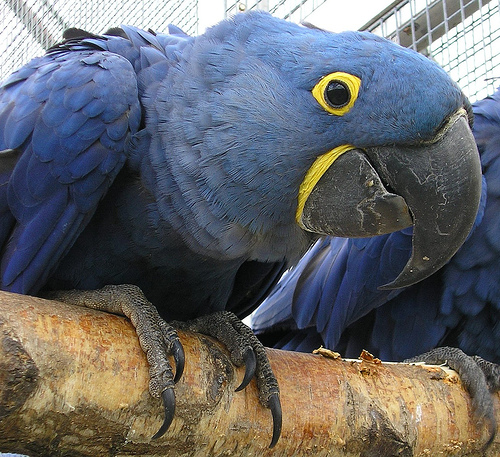
Hyacinth macaw, orHyacinthine macaw(Anodorhynchus hyacinthinus)
Phylum —chordata
Class — aves
Order — psittaciformes
Family — psittacidae
Genus – anodorhynchus
Appearance
The largest parrot by length in the world, the Hyacinth macaw is 1 m (3.3 ft) long from the tip of its tail to the top of its head and weighs 1.2–1.7 kg (2.6–3.7 lb). Each wing is 38.8–42.5 cm (15.3–16.7 in) long. The tail is long and pointed. Its feathers are entirely blue, lighter above. However, the neck feathers can sometimes be slightly grey. The ring around the parrot’s eyes and area just underneath the beak are a strong, vibrant yellow.
Habitat
Hyacinth macaws are native to the neotropics. The geographic range of Hyacinth macaws is from lower Central America to about halfway down the South American continent and is concentrated south of the Amazon River.
Behavior
Hyacinth macaws are very social birds. They perform courting, copulation and bonding activities throughout the year, and are usually seen in pairs. They are most active from morning to mid-afternoon and fly in groups of two to eight to and from the feeding grounds. After feeding they return home to their roosting trees around sunset and spend the night there. Hyacinth macaws are often described as gentle giants, with gentle and loving personalities.
Diet
The majority of the Hyacinth macaw diet is Brazil nuts, from native palms, such as acuri and bocaiuva palms. They have very strong beaks for eating the kernels of hard nuts and seeds. Their strong beaks are even able to crack coconuts, the large brazil nut pods, and macadamia nuts. The birds also boast dry, smooth tongues with a bone inside them that makes them an effective tool for tapping into fruits.
Reproduction
Nesting takes place between July and December, with nests constructed in tree cavities or cliff faces depending on the habitat. Hollows of sufficient size are only found in trees around 60 years of age or older, and competition is fierce. Existing holes are enlarged and then partially filled with wood chips. The clutch size is one or two eggs, although usually only one fledgling survives as the second egg hatches several days after the first, and the smaller fledgling cannot compete with the firstborn for food. A possible explanation for this behavior is what is called the insurance hypothesis. The macaw lays more eggs than can be normally fledged to compensate for earlier eggs that failed to hatch or firstborn chicks that did not survive. The incubation period lasts about a month, and the male tends to his mate whilst she incubates the eggs. The chicks leave the nest, or fledge, around 110 days of age, and remain dependent on their parents until six months of age. They are mature and begin breeding at seven years of age.
In captivity
Hyacinth macaw can live more than 60 years.
These birds demand more time and attention than other species, so Hyacinth macaws are definitely not the right pets for just anybody. Large, beautiful, and intelligent, they can be quite alluring, but resist the temptation to bring a Hyacinth home without thoroughly thinking it through. Caring for this bird is an enormous undertaking that demands a long time commitment.
As might be expected with such a large bird, a Hyacinth macaw requires a spacious area to live. There are very few commercial cages large enough for this bird, and almost none that the bird cannot break out of. Many owners find that a custom-designed cage is necessary, although a full room dedicated to the parrot is even better. This bird needs space to fly about—even if it has had its wing feathers trimmed.
Most regular cages can easily be turned to rubble by the powerful beak. If you must keep the bird in a cage, the best bet is a cage made of stainless steel. Stainless steel cages are far more durable and long-lasting and the benefits of owning one for years outweigh the cost in the long run. A stainless steel cage is a worthwhile investment.
Hyacinth macaws can be very destructive, and it is critical that the cage has lots of wooden toys and branches to chew on. You should expect to replace these frequently.
Like virtually all parrots, the Hyacinth macaw is a highly social animal that requires a lot of interaction with its human caregiver in order to be emotionally happy. Neglected, confined birds are often described as "neurotic," given to screaming, destructiveness, and self-mutilating behaviors such as feather-plucking. If they receive plenty of attention, though, they will prove to be among the friendliest of the macaw species, exceedingly interested in humans.
Although not the most fluent talkers of the macaws, a Hyacinth can learn a few words and phrases, which it will repeat incessantly. They are highly intelligent, and may even learn to use those words in the proper context.
In captivity, they do well on a diet of fruit, vegetables, leafy greens and plenty of nuts, particularly the macadamia nut, as they require more carbohydrates than other parrot species. A pet Hyacinth's diet can be supplemented with specially formulated species-specific pellets.
With a wingspan that can reach 4 feet, they must be given adequate time to exercise and room for a good stretch. It is a good idea to give a Hyacinth a minimum of one to two hours of time each day on a play gym or other safe area per day to maintain their muscles.
These birds also need to chew to maintain their beak and jaws, so plenty of chewable toys are a must for these big beautiful birds. Large toys that can handle the beating of a powerful beak are good choices, as well as toys that have strips or pieces of leather incorporated into them. The bird's impressive beak evolved to crack open large nuts found, and it is instinctive for them to use it for shredding and chipping at hard objects.
 Russian
Russian
 English
English























